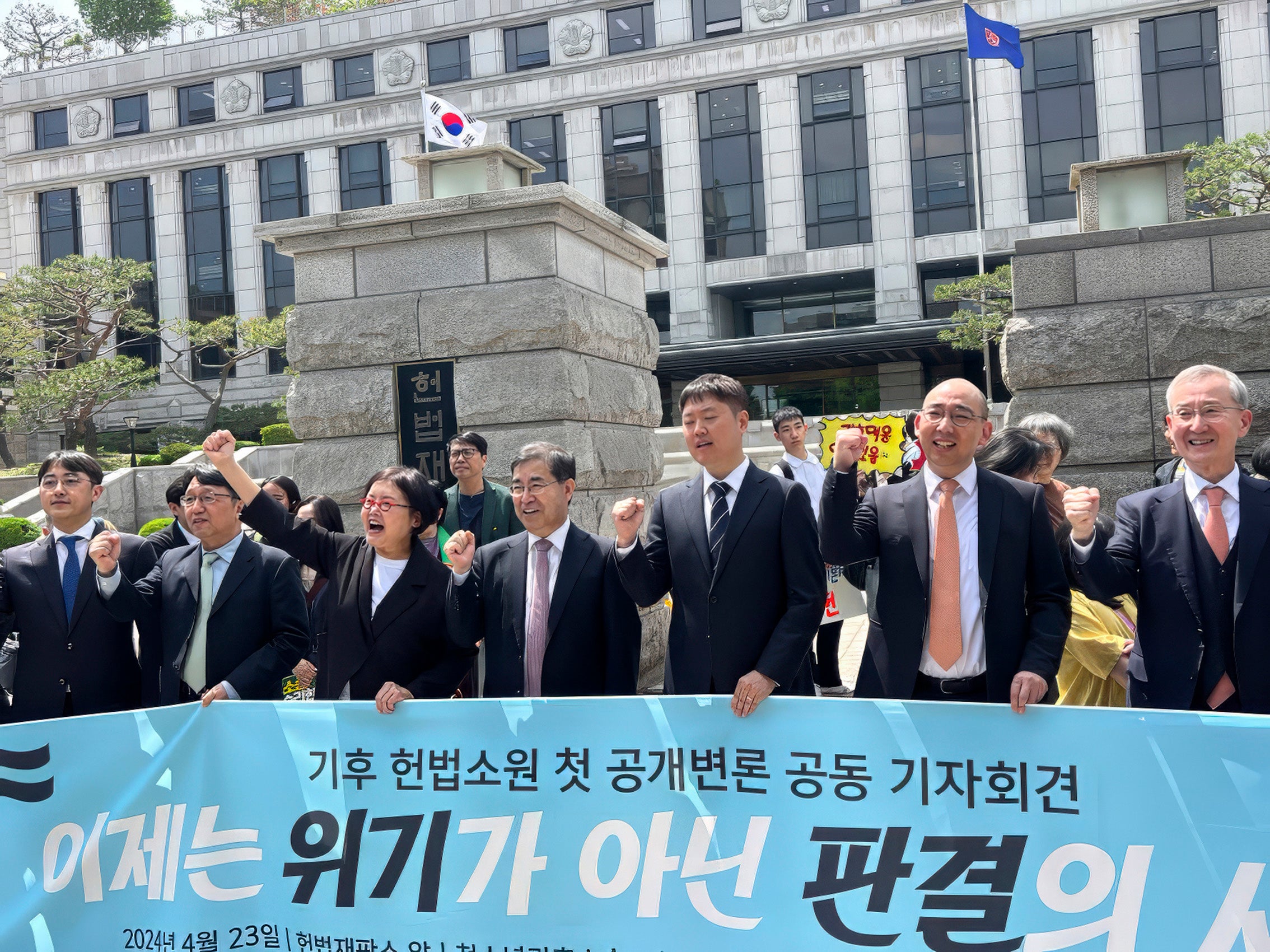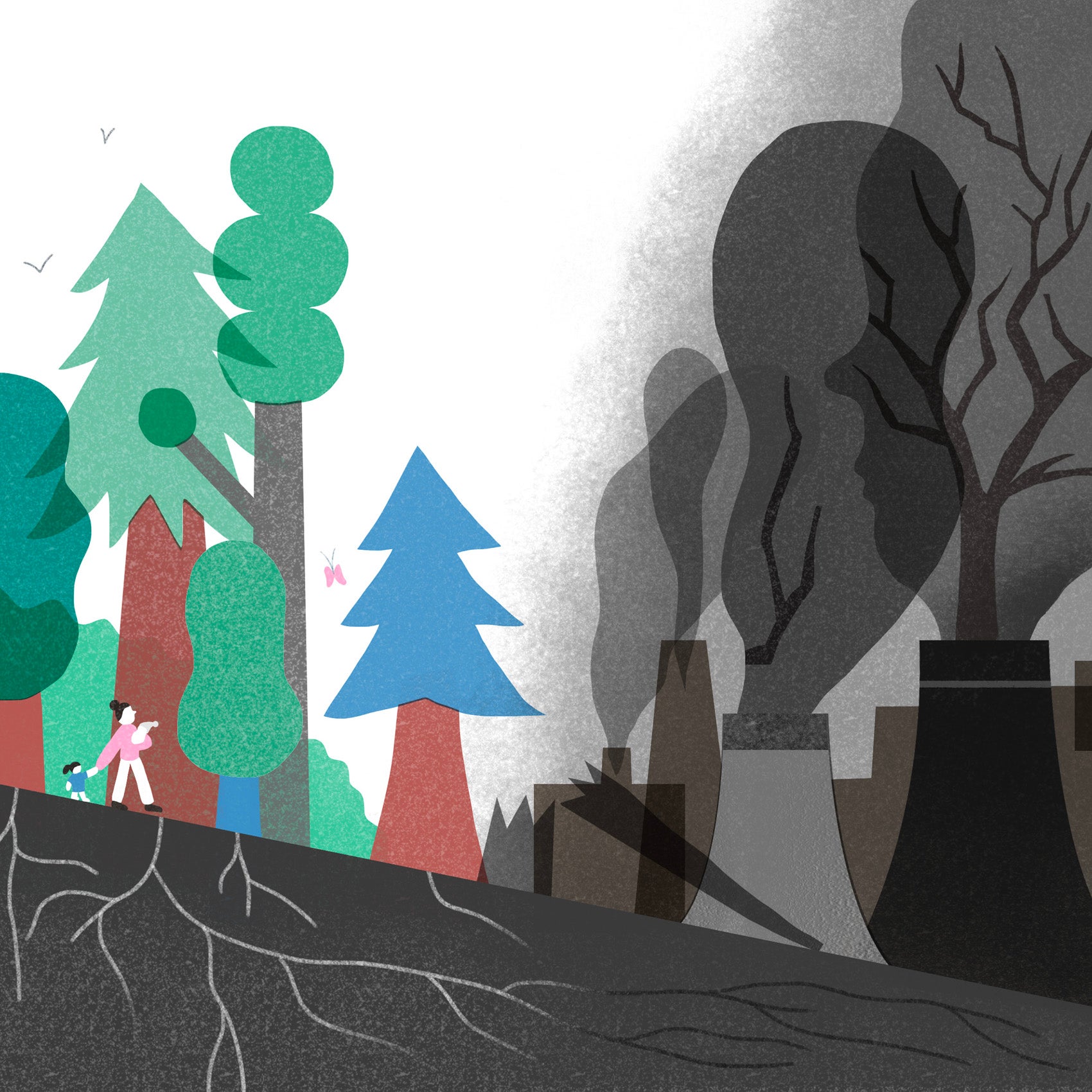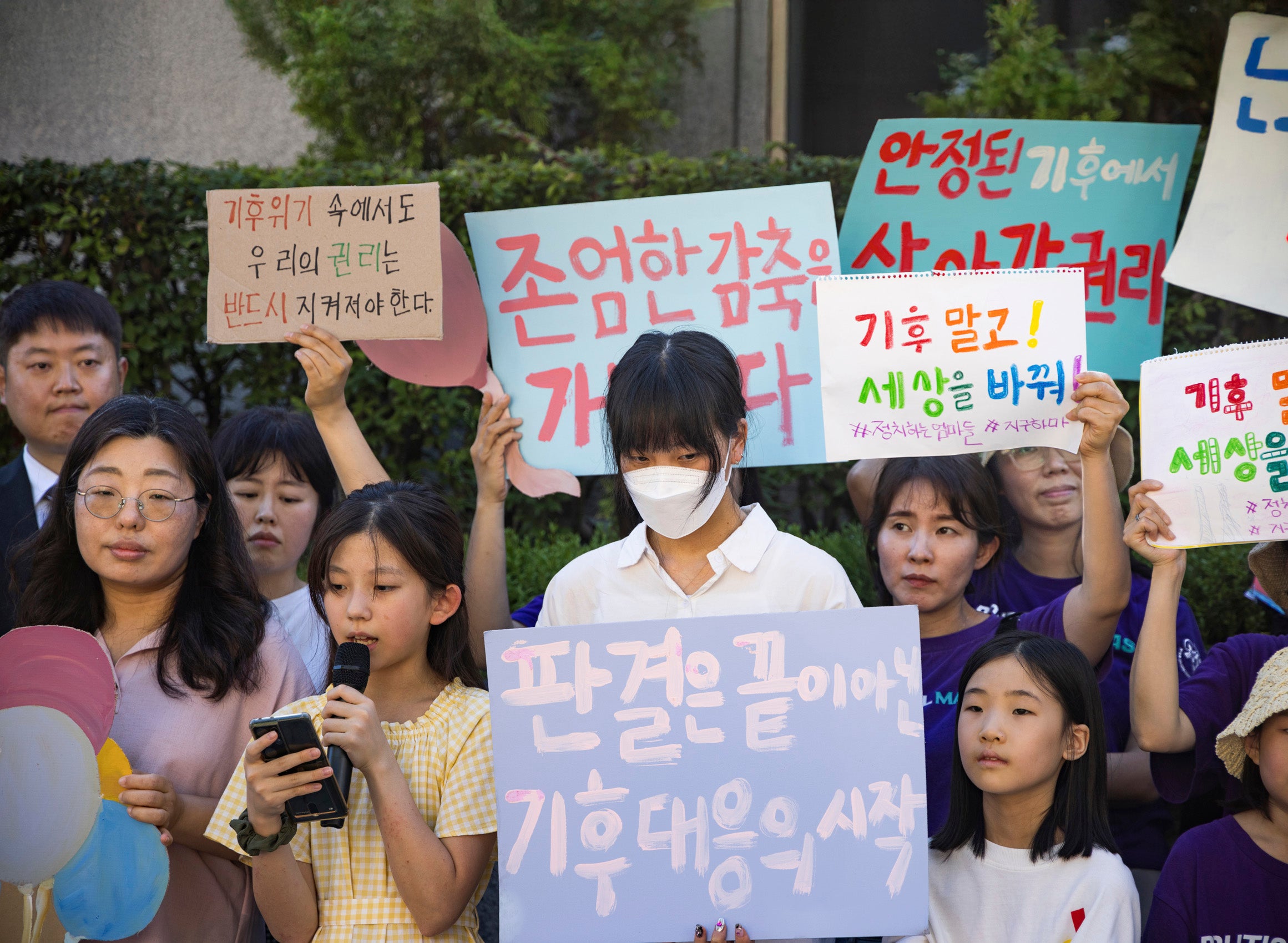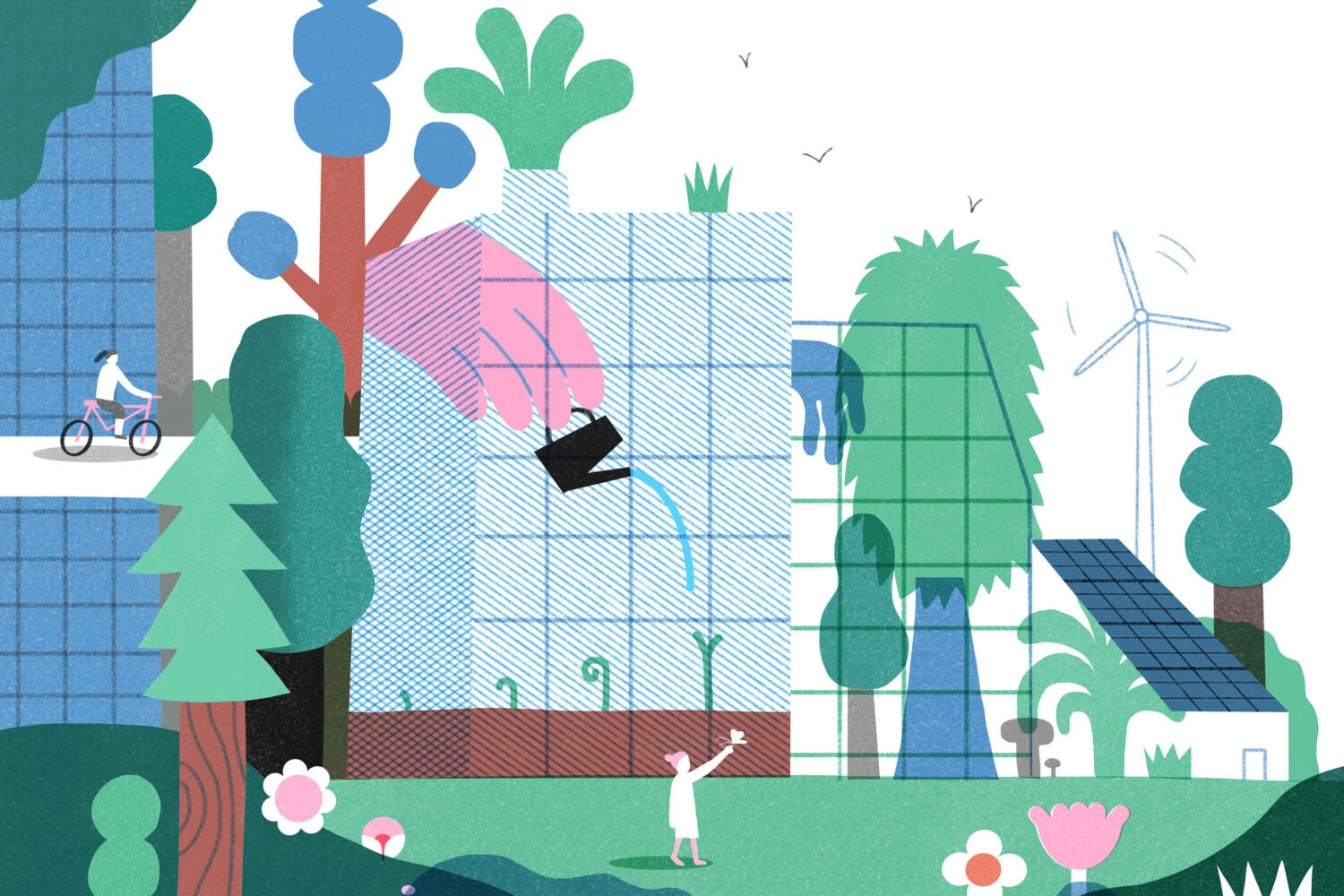On Aug. 29, 2024, days before returning to Harvard Law School for his third year, Jaebok Lee ’25 sat in a courtroom in Seoul, South Korea, awaiting a highly anticipated decision from the Constitutional Court.
A group of young people known as Youth 4 Climate Action were among 250 plaintiffs who’d sued the South Korean government, arguing that its goals for cutting carbon emissions weren’t ambitious enough to protect the rights of citizens, especially future generations who will bear the brunt of climate change.

In the packed courtroom were three Harvard Law alumni who crafted and led the litigation: Lee’s father, Byung-joo “B.J.” Lee LL.M. ’01; Thae Khwarg ’84; and Sejong Youn LL.M. ’19. Outside the courthouse, media from around the world and climate activists anxiously waited as the court worked its way through the other cases on its docket. In one case after another, the justices shot down the constitutional challenges and upheld existing laws. Things didn’t bode well for the climate case.
Finally, the justices began to read the decision. When they declared that a specific article in the Carbon Neutrality Act was unconstitutional, Jaebok Lee was “filled with joy,” he says — but then a woman in front of him burst into tears. “I was a bit confused,” he recalls. “Did it go well — are these tears of joy? Or did it not work out?”
But his father, who’d shaped and argued the legal theories, knew immediately that they’d landed at least a partial victory, and soon it was clear to everyone. In a groundbreaking decision with potential global implications, the court ruled unanimously in favor of the plaintiffs on a key claim — that South Korea’s Carbon Neutrality Act is unconstitutional because it does not provide carbon-reduction targets for the years between 2031 and 2049 and therefore infringes on the environmental rights of future generations. The court gave the country’s National Assembly until February 2026 to devise a stronger carbon reduction plan.
However, the climate litigation team didn’t win everything. The Carbon Neutrality Act, legislated in 2021 and superseding the 2010 Low Carbon Act, required the government to set a carbon-emission reduction goal of at least 35% by 2030 compared with 2018 levels. A 40% reduction was adopted in 2021 by presidential decree, which the plaintiffs argued wasn’t enough. But the court ruled it couldn’t determine the appropriate share of burden that South Korea should bear amid global reduction efforts. That determination, it said, falls within the discretion of the legislative and executive branches. The court also rejected claims against South Korea’s Carbon Neutrality Plan, the administrative implementation plan for the 2030 reduction target.
Still, many regard the decision as a monumental win for climate activists. The government has a constitutional duty to protect a fundamental right to a healthy environment, the court found. This holding opens a wide door for future litigation challenging climate law and policies, according to the Harvard Law alumni. The first victory of its kind in Asia and one of the first in the world, it has been covered by Reuters, The New York Times, The Washington Post, The Guardian, and Nature, among other international media outlets. One Korean constitutional scholar, Jaehong Lee, a professor at Ewha Womans University School of Law in Seoul, described it as a “miraculous decision.”
“The South Korean Constitutional Court’s ruling that current South Korean government efforts to address climate change fall short of the constitutional requirement that each citizen ‘shall have the right to live in a healthy and pleasant environment,’ is plainly historic,” says Richard J. Lazarus ’79, Charles Stebbins Fairchild Professor of Law at Harvard, where he teaches environmental law. “With its decision, the South Korean court [adds to] a series of recent rulings by courts in other nations in favor of environmental plaintiffs, including by Germany and by the European Court of Human Rights regarding Switzerland.”

The South Korean court held that the government has a constitutional duty to protect a fundamental right to a healthy environment.
Before this case, Korean environmental litigation was “a long history of bitter losses,” B.J. Lee says. The victory “marks the start of a new history of winning climate litigations [that] is giving encouragement and excitement to the lawyers and climate activists of other Asian nations.”
In January 2024, Youn notes, youth activists in Taiwan filed similar climate litigation in the Taiwan Constitutional Court, and in August 2024, youth activists in Japan filed a lawsuit against power plants, demanding further reductions in greenhouse gas emissions. “Now that we have a victory in Korea, it can really be a turning point to make this a real global trend,” Youn says. “That’s what we hope.”
‘You can either call it serendipity or some great force at work’
That three Harvard Law alumni should turn from careers in the corporate world to trying to save the natural one is a story of the power of youth activism.
In 2018, the same year 15-year-old Greta Thunberg would organize her first School Strike for Climate, in South Korea teen activists formed the group now called Youth 4 Climate Action. They wanted to find lawyers to help them sue the South Korean government for failing to protect them from the looming threat of climate change. Youn, who had been a corporate lawyer, had just left private practice to join the climate movement in the nonprofit sector when he met the young plaintiffs.

“The danger of climate change, the consequences of inaction, and the intergenerational injustice in all of this were simply undeniable,” says Youn. “Legally, yes, it was definitely a difficult case, to say the least, but it would not have made sense for me to say no to the case because we were working for the same mission.”
Separately, but around the same time, Khwarg also found himself drawn to the issue. After 30 years in investment banking, he had become a senior U.S. attorney at the South Korea-based law firm S&L Partners. In 2018 — “You can either call it serendipity or some great force at work,” says Khwarg — he was introduced by friends to environmental lawyers in the Netherlands who’d won the first case in the world where citizens established the government’s legal duty to protect them from climate change. They, in turn, introduced Khwarg to young South Korean activists interested in similar litigation who were having difficulty finding lawyers willing to sue the government.
“I really got to see that the young students and their parents were taking the looming climate disaster very, very seriously,” says Khwarg. “I then started to think about my grandchildren and how they would not be able to enjoy life the way my generation was able to.”

Khwarg hoped to enlist the support of another partner at the firm, B.J. Lee, a litigation and bankruptcy expert. As a student in the early 1980s, Lee had been imprisoned for 10 months for participating in the protest movement against the military dictatorship of then-President Chun Doo-hwan. He had originally planned to become a human rights lawyer but instead turned to business litigation. “But I always felt some deep burden for my nonparticipation in public legal works,” Lee says.
Still, when Khwarg approached him, Lee, the one-time human rights protester, hesitated. There was no legal precedent for this type of lawsuit in South Korea, “and the concept and form of climate litigation were unknown,” Lee says. He adds that he worried the experience would be “miserable,” and he “did not wish to be a lawyer of a losing case.”
But Khwarg persuaded Lee to join him at a conference convened by the Youth Climate Litigation Group in May 2019. “I heard a dozen young teenage students make speeches about their great fears about the impending climate crisis and the need to make youth climate litigation,” says Lee. “As a father of a young student, I told myself, ‘This youth climate litigation will be a unique lawsuit with a most appealing narrative.’”
Moreover, as the lawsuit is a generational request from children to their parents, asking the older generation to save their lives, he believed that “the judges, who are also parents or grandparents, [would] be unable to easily ignore the young generation’s request and simply turn away,” he says.
Together, Lee and Khwarg convinced the rest of the law firm that the lawsuit would bring benefits that far outweighed any potential loss of corporate clients. While attending meetings organized by climate activists, they met Youn and formed their litigation team. Lee recommended that the best strategy was to challenge the constitutionality of existing laws before the South Korean Constitutional Court. In 2020, they filed suit with 19 teenagers as plaintiffs, and they spent the next four and a half years developing their case.
“The chances were definitely not high at the time of the filing, but we had a clear objective: to achieve a judicial win through arguments that can actually be accepted by the court,” says Youn, who is currently director of Plan 1.5, a Seoul-based nonprofit focused on climate change policy advocacy. He and other Plan 1.5 lawyers were the team’s climate experts, responsible for explaining to the court climate science, international climate law, and the insufficiency of South Korea’s greenhouse gas reduction targets.
In February 2024, the court combined their case with three other climate lawsuits and scheduled a public hearing. Lawyers from the four cases formed a joint team of seven South Korean lawyers, including Lee and Youn, and two U.S. lawyers, including Khwarg. For the next three months, they worked “intensely and fiercely,” Lee says, to prepare final legal briefs, witness statements, answers to the justices’ questions, and opening and closing statements. The youth plaintiffs did “a phenomenal job” maintaining media attention, Youn says, including organizing a petition campaign that collected more than 5,000 signatures.
During opening statement last April and closing statement in May, Youn focused on the scientific and factual reasoning regarding the insufficiency of the reduction target, and Lee focused on the jurisprudential theories on the unconstitutionality of the target law. Khwarg served as the international law adviser and coordinated with the global climate litigation lawyers and experts, including Dutch, German, Irish, French, and U.S. attorneys.
There were many hurdles. “The facts are complicated,” says Youn. “Hashing through the scientific literature and translating them into legal language was indeed a big task.” Moreover, he adds: “The law is also difficult because there are no precedents. The international law sets out principles but provides little basis for concrete and binding obligations. Also, it is not just South Korea that is failing — everybody is, which makes it difficult to argue the state has committed such a big failure that the court has to intervene.”
In his view, Khwarg says: “B.J. and Sejong were the real champions in this landmark case. They thought through every possible line of attack from the government side as well as the nine justices.”
When the ruling was announced, the team was overjoyed — in their eyes, a contrary ruling would have been immoral, given the existential threat posed by climate change.
“The world is on fire but we are acting as if it weren’t,” says Youn. “The consequence of such inaction is disproportionately imposed on the younger generation, and this is an injustice that should not be permitted under the Korean Constitution.”
The path ahead

The ruling is seen as a monumental win for climate activists and could inspire similar cases globally.
The experience had a major impact on all of them. B.J. Lee has since left his firm and opened his own law office to focus on climate justice and other forms of social change. His son, Jaebok Lee, who will focus on international trade at a major U.S. law firm, says, “It was very meaningful for me to sit there in court” as the decision was announced. As an undergraduate, he’d helped the litigation team with translation and other tasks. “It did make me want to be a lawyer who is very conscious of the world around me.”
As for Khwarg, he says, “I’m going to try to do more of this kind of public interest work, because I realized this is actually an area where I can be more impactful.” The team will be monitoring the legislation that the National Assembly has been ordered to draft and won’t hesitate to bring more lawsuits if it falls short, they say. And they will continue to collaborate with climate litigators around Asia and the globe.
“We now have a pretty rich and robust collection of precedents around the world, and it should be easier for other courts to build a case upon those findings” as comparative law perspectives become “much more important,” says Youn.
According to Harvard Law’s Richard Lazarus, “The odds of the U.S. Supreme Court issuing a remotely similar ruling, however, are zero to none. Not just because of the highly conservative makeup of the current Court,” he says, “but more fundamentally because the U.S. Constitution, unlike that of South Korea, lacks language establishing an affirmative individual right to a healthy environment.”
Youn and Khwarg are much more optimistic about the U.S. landscape.
“I don’t necessarily think having a specific environmental rights provision in the constitution was critical for the case,” says Youn, noting that cases in Germany and elsewhere have relied on various other rights, including the right to freedom. And the constitutions of some U.S. states, including Hawaii, provide for specific environmental rights, and lawsuits against corporations are making headway there, Khwarg adds.
“The four and a half years of this dispute actually raised the public awareness on this issue, especially through the voices of the future generation, and they have a very strong and effective voice,” says Youn. “So the fights we have from here on should be different from the fights we have had in the past four and a half years. That’s what we hope. And that’s not just hope. That’s something we need to actually make into reality. So we do have a lot of homework for ourselves as well, but we’re definitely in a better situation now.”
